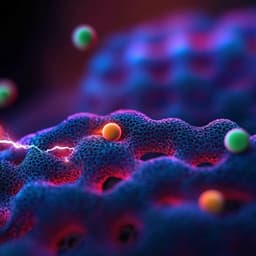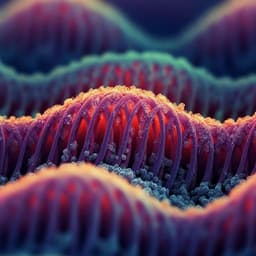
Engineering and Technology
A bioinspired flexible neuromuscular system based thermal-annealing-free perovskite with passivation
J. Liu, J. Gong, et al.
Explore the groundbreaking research conducted by Jiaqi Liu and colleagues, showcasing a novel flexible artificial synapse using a room-temperature crystallized perovskite layer. This innovation not only achieves a record-low energy consumption and ultrafast response but also powers an artificial neuromuscular system, laying the foundation for advancements in bio-inspired electronics and neurorobotics.
~3 min • Beginner • English
Introduction
The study addresses the need for ultra-low-energy, high-speed, and flexible artificial synapses for brain-inspired electronics, where energy efficiency of memory and processing units is critical. Organic–inorganic hybrid perovskites (OHPs) are promising due to low activation energies and mixed ionic/electronic conduction, but conventional solution-processed films suffer from abundant defects (non-radiative recombination centers), poor stability, and higher synaptic energy from excessive ion hopping. Traditional perovskite inks employ high-boiling solvents requiring thermal annealing and long processing times, which are incompatible with low glass transition temperature plastic substrates for flexible electronics. Therefore, passivating intrinsic defects and developing a spontaneous room-temperature (RT) crystallization process are necessary. Beyond computation, next-generation bioinspired robots require physical intelligence, including motion-state feedback such as muscular-fatigue warnings analogous to biological adenosine-mediated fatigue perception. This work proposes an RT-fabricated, passivated perovskite artificial synapse enabling ultralow energy operation, high speed, mechanical flexibility, and integration into a neuromuscular system capable of fatigue warning.
Literature Review
Prior work highlights the efficiency of neuromorphic systems over von Neumann architectures and the promise of OHPs for low-energy artificial synapses due to mixed ionic/electronic transport and low ion migration barriers. However, conventional perovskite films made via high-boiling-point solvents require thermal annealing and long times, leading to high defect densities that accelerate degradation and increase energy consumption. Defect passivation (e.g., with PEAI) has improved perovskite optoelectronics in solar cells by reducing non-radiative recombination and stabilizing surfaces. Attempts at artificial neuromuscular systems often lack higher-level motion-status feedback (physical intelligence) like fatigue warning. The literature motivates a need for RT processing compatible with flexible substrates, effective passivation strategies to suppress trap states and ion migration, and neuromorphic platforms that integrate sensing–actuation with feedback.
Methodology
Materials and ink preparation: MAPbI3 precursor (1.1 mol/L) prepared by dissolving MAI and PbI2 (1:1 molar ratio) in a methylamine (30–33% in ethanol) and acetonitrile (ACN) mixed solvent (volume ratio 3:2), stirred 1 h at room temperature. PEAI passivation solution: 5 mg/mL PEAI in isopropanol (IPA), dissolved for 2 h. All chemicals used as received.
Room-temperature perovskite formation: Spin-coating of MAPbI3 from a low-boiling mixed solvent (methylamine–ethanol and ACN) forms an alcohol-soluble metastable intermediate MAPbI3·n(MA) via coordination of CH3NH2 to Pb2+. Rapid solvent evaporation at RT drives MA escape and spontaneous transformation to tetragonal β-phase MAPbI3 within ~10 s, confirmed by Gibbs free energy calculations and in-situ PL (redshift from ~768 to ~786 nm, bandgap 1.62→1.58 eV). A [001]-preferred orientation polycrystalline film is obtained.
Passivation: Post-deposition spin-coating of PEAI forms a thin surface passivation layer. XRD shows dominant MAPbI3 (002)/(004) peaks with an additional 4.7° PEAI peak, indicating PEAI salt presence rather than 2D (PEA)2PbI4. SEM/AFM show smoothing and reduced roughness (Rrms 14.2→2.16 nm) with grain-boundary coverage. XPS indicates reduced Pb 4f binding energies and disappearance of undercoordinated Pb2+ signatures; increased I 3d confirms iodine enrichment and vacancy filling.
Device fabrication: Substrate: PET/ITO cleaned (DI water, acetone, IPA; 15 min each), N2-dried, UV-ozone 20 min. Perovskite deposition: 100 μL MAPbI3 solution spin-coated at 4000 rpm for 60 s. Passivation: 70 μL PEAI solution spin-coated at 4000 rpm for 30 s. Au top electrodes deposited by thermal evaporation through a shadow mask. All deposition in N2 glovebox at RT. Device stack: PET-ITO/MAPbI3/PEAI/Au.
Electrical and synaptic characterization: I–V hysteresis and cycling (50 cycles, dark), device-to-device/cross-chip statistics (10 chips, random devices), air-exposure stability (up to 240 h), and bending endurance (radius 4.5 mm, up to 2000 cycles). Short-term plasticity tests: paired-pulse facilitation (PPF), spike-duration dependent plasticity (SDDP), spike-rate dependent plasticity (SRDP), potentiation/depression with varied pulse amplitudes, linearity and residual ratio analysis, and endurance under repeated pulses. Ultra-low-energy testing with 15 mV, 100 ns spikes across device sizes; computation of energy per event; maximum response frequency via MHz spike trains.
Defect and ion dynamics analysis: SCLC to extract trap-filled limit voltage (VTFL) and trap density; TRPL for carrier lifetime; i-KPFM to monitor surface potential under small bias (15 mV); TOF-SIMS for depth/planar distributions of I− and PEAI phenethyl groups; AFM for topography and grain boundaries. DFT calculations to obtain iodide migration activation energies for vertical (along PbI6 octahedra) and lateral (through MA+ gaps) pathways.
Neuromuscular system: Integration of perovskite synapse output with an ionic polymer–metal composite (IPMC) artificial muscle (Pt/Nafion/Pt). IPMC operates at ~2–3 V with ~0.33 A at 3 V. Circuit interfaces synaptic postsynaptic current-derived control signals to IPMC to realize graded bending proportional to synaptic accumulation. Demonstrated logic (AND/OR) via multi-terminal inputs and thresholding. Implemented associative (Pavlovian) learning using two presynaptic inputs (“food” and “bell”) with threshold crossing indicating response. Designed a fatigue-warning circuit where small deflection triggers a green signal (terminal α), excessive deflection (>90°) triggers a red alarm (terminal β).
Key Findings
- Rapid RT crystallization: MAPbI3 films crystallize within ~10 s at room temperature from a methylamine–ethanol/ACN solvent, yielding [001]-oriented films.
- Effective passivation: PEAI forms a surface layer (XRD peak at 4.7°), smooths morphology (AFM Rrms 14.2→2.16 nm), reduces undercoordinated Pb2+ (XPS), enhances PL/TRPL, and fills iodine vacancies.
- Reduced traps: SCLC VTFL decreases 0.46→0.21 V; calculated trap density drops from 3.14×10^15 to 1.43×10^15 cm−3.
- Reproducible memristive behavior: 10 devices across 10 chips show hysteresis with on/off >10^3; stable over cycles and after 5 h; air stability retains >73% conductance after 200 h.
- Ultra-low energy synapse: Under 15 mV, 100 ns spikes, energy per synaptic event averages 13.5 aJ across 100 devices (chip-wise 12.81–14.11 aJ), with minimum ~−13.42 aJ for 100 μm device; energy and current scale with device size.
- Ion migration dynamics: DFT finds lowest activation energy 0.597 eV for vacancy-assisted iodide migration along PbI6 vertical path. i-KPFM shows surface potential shift (0.721→0.613 V) under 15 mV, indicating I− migration; TOF-SIMS confirms upward I− migration after 500 spikes.
- High-speed operation: Maximum response frequency reaches 4.17 MHz, the fastest reported for perovskite synapses; stable repeated operation and observable PPF at ultrahigh frequency.
- Mechanical flexibility: After 2000 bending cycles (radius 4.5 mm), passivated devices maintain I–V characteristics and ~7 nS conductance; unpassivated drops 80.4→66.3 nS. PPF index remains stable with passivation.
- Synaptic functions: Demonstrated PPF, SDDP (longer pulse durations increase EPSC), SRDP (higher spike rate enhances EPSC), improved linearity at lower amplitudes (−0.1 to −1 V), and stable potentiation/depression over 1800 pulses.
- Logic and learning: Thresholded multi-input logic (AND at low Vre; OR at higher Vre), spatiotemporal summation with maximum when ΔT=0 ms, and associative (Pavlovian) learning enabling a trained “bell” stimulus to elicit threshold-crossing response.
- Neuromuscular integration: Passivated synapse shows stronger accumulation (accumulative index 362.9% vs 245% unpassivated after 30 spikes), driving IPMC bending; graded deflection correlates with EPSC and exceeds 90° after 40 spikes; implemented muscular-fatigue early warning (green for small deflection, red for excessive deflection).
Discussion
The RT-fabricated, PEAI-passivated MAPbI3 synaptic device directly addresses the challenge of achieving ultra-low energy, high-speed, and mechanically flexible artificial synapses suitable for bioinspired electronics. RT processing avoids thermal annealing, enabling fabrication on low-Tg plastic substrates. PEAI passivation suppresses defect and ion migration pathways, reflected in reduced trap density, enhanced carrier lifetime, and smoother morphology, collectively enabling attojoule-level switching and MHz-rate operation while preserving synaptic plasticity (PPF, SRDP, SDDP). The devices show stable hysteresis, environmental tolerance, and mechanical robustness under bending, supporting practical flexible applications. Integrating the synapse with an IPMC actuator establishes a functional neuromuscular system exhibiting accumulative processing, logic, spatiotemporal summation, associative learning, and, importantly, a fatigue-warning capability. This demonstrates not only computational intelligence but also physical intelligence modules needed for neurorobotics, showing that perovskite synapses can serve as low-power control units for soft actuators with built-in safety feedback.
Conclusion
The work introduces a room-temperature, thermal-annealing-free perovskite synaptic device with PEAI passivation that delivers record-low energy consumption (~13.5 aJ per event), ultrafast response (up to 4.17 MHz), and reliable flexibility under mechanical stress. The approach simplifies manufacturing on flexible substrates and enhances device stability by reducing defects and ion migration. A neuromuscular electronic system combining the synapse with an IPMC artificial muscle realizes graded actuation, logic operations, associative learning, and a muscular-fatigue early warning function, highlighting potential in neuromorphic bioelectronics and neurorobots. Future research could optimize device scaling for even lower energies, explore long-term environmental stability and encapsulation strategies, integrate larger arrays for complex computing, and expand multimodal sensing–actuation systems with advanced feedback control.
Limitations
Related Publications
Explore these studies to deepen your understanding of the subject.







